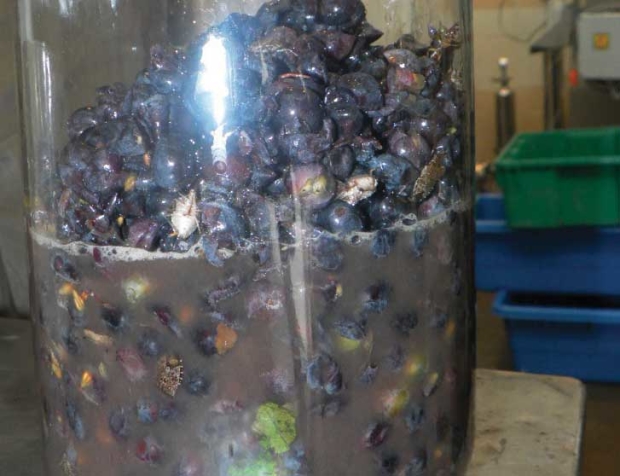
Brown marmorated stinkbug were added to Pinot Noir grapes. Researchers analyzed juice and wine throughout the winemaking process to learn if the stinkbug odor could taint or contaminate the wine. (Courtesy Oregon State University)
The findings of brown marmorated stinkbug in two commercial wine grape vineyards in Washington State and in Oregon’s Willamette Valley raise the question: Can the pest—with its foul odor—impact wine quality?
Research to answer that question is ongoing. Definitive answers are needed because initial studies found mixed results for stinkbug taint in wine.
Early studies done in 2010 by the University of Maryland found that adding up to 50 stinkbugs per lug of grapes resulted in perceptible taint in juice for about four months, but the perceptible taint in the juice did not result in perceptible sensory taint in the wine. (Read “Brown marmorated stinkbug in grapes and wine,” from November 2012.)
It was also learned early on that the foul odor of the brown marmorated stinkbug, described to smell “green” like cilantro, doesn’t appear to survive pasteurization in making grape juice.
But preliminary results from a more recent study conducted at Oregon State University found that only a few brown marmorated stinkbugs per cluster could contaminate Pinot Noir wines with perceptible taint.
Dr. Elizabeth Tomasino, an OSU food scientist, says the biggest difference between the studies by OSU and the University of Maryland research is that stinkbug did not go through full winemaking steps in the UM research but were contained in bags that “soaked” in the juice during fermentation.
By following stinkbug throughout all wine processes, as does the OSU project, wineries have a more realistic picture for potential contamination.
The work at OSU began during crush of 2013 and is under review for publication in scientific journals.

This sample of Pinot Noir grapes, spiked with brown marmorated stinkbug, was turned into wine to learn if the stinkbug’s foul odor can impact wine quality. (Courtesy Oregon State University)
Tomasino said the research team wanted to learn what wine processing stages were responsible for brown marmorated stinkbug taint release and how many stinkbugs in grape clusters it took before consumer rejection.
They also wanted to evaluate the effectiveness of fining agents in taint removal.
Treatments of up to three stinkbugs per cluster were followed throughout winemaking stages, from crushing and de-stemming to fermenting and pressing to aging in bottles.
Specialized gas chromatography was used at more than six processing steps to measure trans-2-decenal, the aroma compound reported to cause the stinkbug taint.
The effectiveness of the fining agents was assessed by chemical analysis and sensory descriptive analysis.
Although project details were not yet available, Tomasino reported to Good Fruit Grower that taint levels were found to increase with bug densities and that de-stemming and pressing were major contributors of the release of brown marmorated stinkbug taint.
The type of press and pressure program also affected the taint levels released during pressing. She added that grapes with three stinkbugs per cluster have potential to result in wine with taint that is at or above the consumer rejection threshold (the level at which consumers would begin rejecting the wine due to taint).
Data on the potential to reduce taint from fining agents are still being analyzed.
In addition to the issue of taint in wines, brown marmorated stinkbug feeding on grapes before harvest can cause secondary pest attacks and increase the chance for disease infection.
Brown marmorated stinkbug, introduced from Asia into the Mid-Atlantic region in the mid-1990s, has gone from being a nuisance pest in homes to a potentially devastating pest causing serious economic crop damage. The stinkbug has been found in 40 states. •
-by Melissa Hansen






[…] news release from Washington State University on brown marmorated stink bug research. According to this 2017 report from WSU, the pest has been found in Walla Walla Valley vineyards, but no damage has been […]